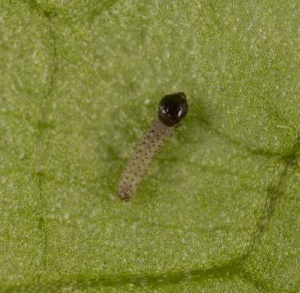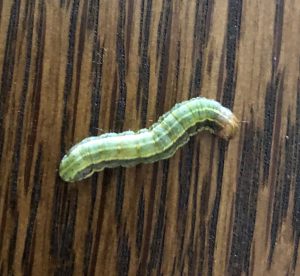
A newly hatched armyworm –photo by Lyle Buss
With a population that never seems to quite disappear in North Florida, the armyworm is a caterpillar pest of many plants. There are four types found in our area: fall, southern, yellow-striped, and beet armyworms. The caterpillars pupate into moths, which breed roughly from April to December, but warmer weather may lead to them being sighted even in the middle of winter. Adult moths, which are relatively nondescript and gray-brown in appearance, lay masses of 100-200 eggs on plants. Young armyworms are tiny and very difficult to detect, often hiding during the brightest parts of the day.
The armyworm grows to a length of about 1 ¼ inches, taking about two weeks to reach its full size. The caterpillar builds a cocoon in the soil and pupates into a moth, living another one to three weeks. With its ability to eat a broad range of plants, this can lead to large populations of these insects in a relatively short time.
Armyworms seem to prefer eating grasses (especially Bermudagrass in lawns), but will chew on almost anything in their path. They have been observed eating citrus trees, tobacco, cotton, strawberries, and even weeds like pigweed and nutsedge. A hungry armyworm might even turn on its fellow caterpillars, eating them as well if they are too close. When large numbers of these pests are present, the damage they do to surrounding foliage can be stark. Young caterpillars may skeletonize leaves, while older larvae will make holes in leaves or defoliate plants fully.
Years with an abundance of wet or humid weather seem to help armyworms reproduce. Armyworms seem to be attracted to newly established turf, and heavy fertilization of turfgrass in late summer can also cause populations to build. Scout for them

A beet armyworm. –photo by Serena Robison
during cooler hours of the day, or when it is overcast or rainy. Mixing a tablespoon of dishwashing soap in a gallon of water and pouring it over a four-square foot area will cause insects to crawl to the surface – do this if damage is present and armyworms are suspected. For lawns, treatment at the first sight of damage may help, though a lawn may very well survive an attack by armyworms. If chemical control is necessary, there are numerous options. Products containing the active ingredients Bacillus thuringiensis, acephate, bifenthrin, carbaryl, permethrin, spinosad, and others have all been labeled for use on armyworms.
For more information, see our EDIS publication on fall armyworm at https://edis.ifas.ufl.edu/in255 or contact your local Extension office.
- Quercus Geminata, the Sand Live Oak - November 20, 2025
- Snakes of the Panhandle - October 10, 2025
- Ganoderma, a Deadly Disease of Palms - September 4, 2025

